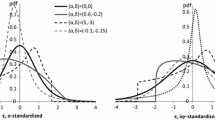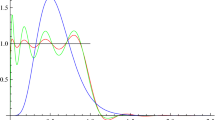Abstract
In Final Offer Arbitration the arbitrator has to choose between two prices – salary offer a and demand b, presented by two negotiating sides. This situation is common e.g., in Major League Baseball since 1974, for players with at least three years experience. We model the arbitrator's decision process as follows. First, the arbitrator chooses an appropriate sum Z. Then he selects the one among a and b which is closer to the ‘proper sum’Z. The final amount selected is Y . Based on the history of n cases, the information available is the triplets {(Y i, a i, b i) : i= 1, 2, . . . n}(the {Z i} are hidden). It is assumed that the {Z i} are random variables with a distribution which depends on an unknown parameter q and the challenge is to estimate q. Furthermore, since each case had different merits and characteristics, the resulting distribution is case-specific. Thus, our model allows the inclusion of explanatory variables. The statistical algorithm which we shall use is the Expectation-Maximization(EM) algorithm. In the paper, the statistical model is introduced in detail and the application of the EM algorithm to the available data is explained. Two numerical examples illustrate the use of the EM algorithm in estimating the arbitrator's hidden judgements.
Similar content being viewed by others
References
Ashenfleter, O. and D. E. Bloom. (1984). “Models of Arbitrator Behavior: Theory and Evidence,” American Economic Review 74, 111–124.
Brams, S. J. and S. Merrill III. (1983). “Equilibrium Strategies for Final-Offer Arbitration: There Is No Median Convergence,” Management Science 29, 927–941.
Brams, S. J. and S. Merrill III. (1991). “Final-Offer Arbitration With a Bonus,” European Journal of Political Economy 7, 79–92.
Brams, S. J., D. M. Kilgour, and S. Merrill III. (1991). “Arbitration Procedures,” in H. P. Young (ed.), Negotiation Analysis. Ann Arbor, MI: University of Michigan Press, 47–65.
Draper, N. R. and H. Smith. (1998). Applied Regression Analysis, 3rd Ed., Wiley.
Farber, H. S. (1980). “An Analysis of Final-Offer Arbitration,” Journal of Conflict Resolution 5, 683–705.
Gibbons, R. (1992). Game Theory for Applied Economists. Princeton, NJ: Princeton University Press.
Kilgour D. M. (1994). “Game-Theoretic Properties of Final-Offer Arbitration,” Group Decision and Negotiation 3, 285–301.
Lehmann, E. L. and G. Casella. (1998). Theory of Point Estimation, 2nd Ed., Springer.
Royce, N. (1997). Salary Arbitration in Major League Baseball: History, Critique and Solutions for the Future. http://wst-jeneault.syr.edu/classes/209/syll/writing/royce.html.
Tanner, M. A. (1996). Tools for Statistical Inference: Methods for the Exploration of Posterior Distributions and Likelihood Functions, 3rd Ed., Springer.
Author information
Authors and Affiliations
Rights and permissions
About this article
Cite this article
Gerchak, Y., Greenstein, E. & Weissman, I. Estimating Arbitrator's Hidden Judgement in Final Offer Arbitration. Group Decision and Negotiation 13, 291–298 (2004). https://doi.org/10.1023/B:GRUP.0000031090.95226.db
Issue Date:
DOI: https://doi.org/10.1023/B:GRUP.0000031090.95226.db




